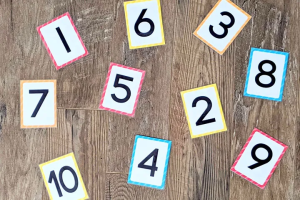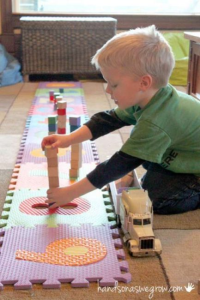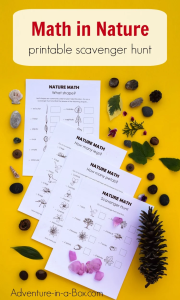Welcome to One More One Less Games, where mathematics meets adventure!
In this thrilling collection of educational games, children will embark on a quest to master the concept of one more and one less.
With each game carefully designed to engage and challenge young minds, players will develop their counting skills, improve number recognition, and strengthen their understanding of numerical order.
From counting objects to identifying missing numbers in sequences, these games provide an exciting and interactive way for children to explore the world of numbers.
So prepare for a thrilling journey filled with puzzles, rewards, and the opportunity to become a math whiz!
Number Line Race:

Set up a number line on the floor or use a large one on a whiteboard. Gather a group of children and explain that they will be participating in a Number Line Race. Each child will take turns rolling a dice and then moving their game piece along the number line. The goal is to practice identifying one more or one less than the number rolled. For example, if a child rolls a 4, they can choose to move their game piece one spot forward (one more) or one spot backward (one less). The first child to reach the end of the number line wins! This game encourages quick thinking, and number recognition, and reinforces the concept of one more and one less.
Missing Number Challenge:

Create a set of cards with numbers written on them, leaving some numbers missing. Shuffle the cards and place them face down in a pile. Each child takes turns drawing a card and reading out the numbers on the card. The challenge is to identify the missing number by determining what comes with one more or one less than the given numbers. For instance, if the card shows 5 and 7, the missing number is 6. Children can take turns being the “game master” and creating their own missing number cards for their friends to solve. This activity promotes critical thinking, and number sequencing, and reinforces the concept of one more and one less.
Counting Caterpillars:

Create a set of caterpillar cutouts, each labeled with a number from 1 to 15. Provide children with a variety of small objects such as buttons, beads, or colored pom-poms. Instruct them to count out the correct number of objects to place on each caterpillar, starting with the number 1. Once they have placed the correct number of objects on the first caterpillar, encourage them to determine how many more or fewer objects the next caterpillar needs. For example, if the first caterpillar has 3 objects, they will need to place 4 objects on the next one (one more), and then 2 objects on the following caterpillar (one less). This hands-on activity reinforces counting skills, number sense, and the concept of one more and one less.
Related: 20 Easy Breathing Exercises for Preschool Kids
One More One Less Card Game:

This engaging card game is a fun way to reinforce number sense and practice addition and subtraction skills. To play, create a deck of cards with numbers from 1 to 20. Each player is dealt a hand of cards, and the remaining cards are placed facedown in a draw pile. Players take turns playing a card from their hand and must either add one or subtract one from the number on the card to determine the next card to be played. For example, if a player plays a card with the number 8, the next card played must be a 7 or a 9. The first player to get rid of all their cards wins the game. This activity not only sharpens mental math abilities but also encourages strategic thinking and decision-making.
One More One Less Number Line Hop:

This active and kinesthetic game is perfect for getting kids up and moving while practicing number recognition and sequencing. Create a large number line on the floor using masking tape or chalk. Start with a number and have the child stand on that number. Then, call out “One more!” or “One less!” and the child must hop forward or backward to the correct number. For example, if the child is standing on the number 10 and you say “One more!”, they should hop to the number 11. This game can be adapted for different age groups and abilities by using larger or smaller number ranges. It’s a fantastic way to reinforce numerical concepts while promoting physical activity.
One More One Less Puzzles:

Puzzles are a fantastic tool for cognitive development and problem-solving skills. For this activity, create a set of number puzzles by writing numbers on individual puzzle pieces and then cutting them into two pieces each. Mix up the pieces and have the child match the number on one piece with the corresponding number that is either one more or one less on the other piece. For example, if one piece has the number 5, the matching piece should have either the number 4 or 6. As the child solves the puzzles, they reinforce the concept of one more and one less while also improving their fine motor skills and logical thinking.
Related: 15 Inspiring Vision Board Ideas for Kids
One More One Less Dice Game:

Turn to learn into playtime with a dice game that focuses on number relationships. To play, you will need two dice. Each player takes turns rolling the dice and then determines the number that is one more or one less than the sum of the two dice. For instance, if a player rolls a 3 and a 4, they can choose to either add 1 to get 8 (3+4+1) or subtract 1 to get 6 (3+4-1). Players earn points for correctly identifying the numbers that are one more or one less, and the player with the highest score after a predetermined number of rounds wins the game. This game enhances mental math skills, number recognition, and quick thinking.
One More One Less Dominoes:

Adapt the classic game of dominoes to practice one more and one less. Use a set of dominoes and assign each player a certain number of dominoes. The first player places a domino on the playing area, and the next player must match one of the numbers on the domino with a domino that is one more or one less than the number. For example, if one side of the domino has a 4, the player can place a domino with a 3 or a 5 on it. This game encourages critical thinking, number recognition, and strategic decision-making.
One More One Less Bean Bag Toss:

Set up a bean bag toss game with numbered targets. Each target represents a different number. Have the players take turns tossing bean bags and aiming for the targets. After landing a bean bag on a target, the player must identify a number that is one more or one less than the number on the target. For example, if the target has the number 12, the player could say “One more is 13” or “One less is 11.” This game promotes hand-eye coordination, number recognition, and quick mental calculations.
One More One Less Tower Building:

Use building blocks or stacking toys to create a tower. Each block represents a different number, and the tower starts with a designated number. Players take turns adding or removing blocks to the tower while correctly stating the number that is one more or one less than the current number. For example, if the tower has the number 8, a player can add a block and say “One more is 9” or remove a block and say “One less is 7.” This activity encourages fine motor skills, number sense, and logical reasoning.
One More One Less Bingo:

Create a Bingo game board with numbers arranged in a grid. Use number cards or write the numbers on pieces of paper. Call out a number, and players must identify a number that is one more or one less than the called number. If they have the corresponding number on their board, they can cover it. The first player to form a line, either horizontally, vertically, or diagonally, shouts “Bingo!” This game reinforces number recognition, mental calculations, and listening skills.
One More One Less Relay Race:

Organize a relay race with multiple stations. Each station has a number card, and players must run to the station, identify the number, and state a number that is one more or one less than the given number. They then pass the baton to the next player, who does the same at the next station. The team that completes the relay race first wins. This activity combines physical activity, teamwork, and mathematical thinking.
One More One Less Memory Game:

Create a memory game using pairs of number cards. Each pair consists of a number and its corresponding number is one more or one less. Shuffle the cards and lay them face down. Players take turns flipping two cards, aiming to find a matching pair of numbers and their one more/one less counterparts. They must also state the number relationship when making a match. This game improves memory skills, concentration, and number sense.
One More One Less Sorting Game:

Prepare a set of cards with various numbers and objects, such as pictures of animals or shapes. Players sort the cards into two groups: one group represents numbers that are one more than the given number, and the other group represents numbers that are one less. For example, if the number is 10, cards with the number 11 or 9 would go into the respective groups. This activity promotes visual discrimination, number sense, and categorization skills.v
One More One Less Outdoor Scavenger Hunt:

Take the concept of a scavenger hunt outdoors. Create a list of natural objects or features, such as rocks, leaves, or trees, and assign each item a number. Provide the participants with a starting number and instruct them to find objects that are one more or one less in numerical order. For example, if the starting number is 10, they may need to find a leaf with 9 or 11 points. This activity combines outdoor exploration, observation skills, and number sense.


